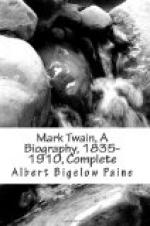We drove to the hotel and dined that night with the Dodges, who had been neighbors at Riverdale. Later, the usual crowd of admirers gathered around him, among them I remember the minister from Costa Rica, the Italian minister, and others of the diplomatic service, most of whom he had known during his European residence. Some one told of traveling in India and China, and how a certain Hindu “god” who had exchanged autographs with Mark Twain during his sojourn there was familiar with only two other American names—George Washington and Chicago; while the King of Siam had read but three English books—the Bible, Bryce’s American Commonwealth, and The Innocents Abroad.
We were at Thomas Nelson Page’s for dinner next evening—a wonderfully beautiful home, full of art treasures. A number of guests had been invited. Clemens naturally led the dinner-talk, which eventually drifted to reading. He told of Mrs. Clemens’s embarrassment when Stepniak had visited them and talked books, and asked her what her husband thought of Balzac, Thackeray, and the others. She had been obliged to say that he had not read them.
“‘How interesting!’ said Stepniak. But it wasn’t interesting to Mrs. Clemens. It was torture.”
He was light-spirited and gay; but recalling Mrs. Clemens saddened him, perhaps, for he was silent as we drove to the hotel, and after he was in bed he said, with a weary despair which even the words do not convey:
“If I had been there a minute earlier, it is possible—it is possible that she might have died in my arms. Sometimes I think that perhaps there was an instant—a single instant—when she realized that she was dying and that I was not there.”
In New York I had once brought him a print of the superb “Adams Memorial,” by Saint-Gaudens—the bronze woman who sits in the still court in the Rock Creek Cemetery at Washington.
On the morning following the Page dinner at breakfast, he said:
“Engage a carriage and we will drive out and see the Saint-Gaudens bronze.”
It was a bleak, dull December day, and as we walked down through the avenues of the dead there was a presence of realized sorrow that seemed exactly suited to such a visit. We entered the little inclosure of cedars where sits the dark figure which is art’s supreme expression of the great human mystery of life and death. Instinctively we removed our hats, and neither spoke until after we had come away. Then:
“What does he call it?” he asked.
I did not know, though I had heard applied to it that great line of Shakespeare’s—“the rest is silence.”
“But that figure is not silent,” he said.
And later, as we were driving home:
“It is in deep meditation on sorrowful things.”
When we returned to New York he had the little print framed, and kept it always on his mantelpiece.




